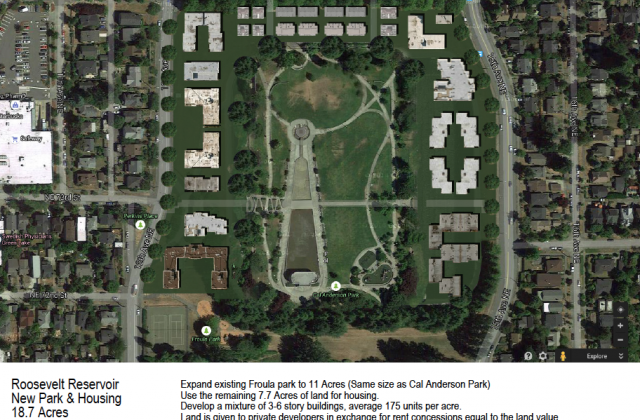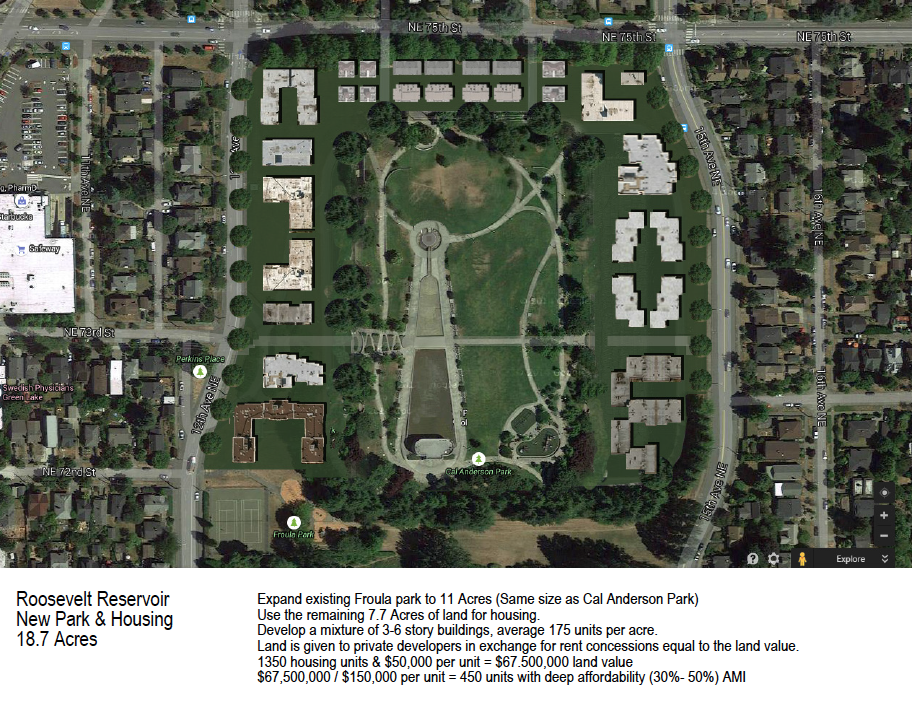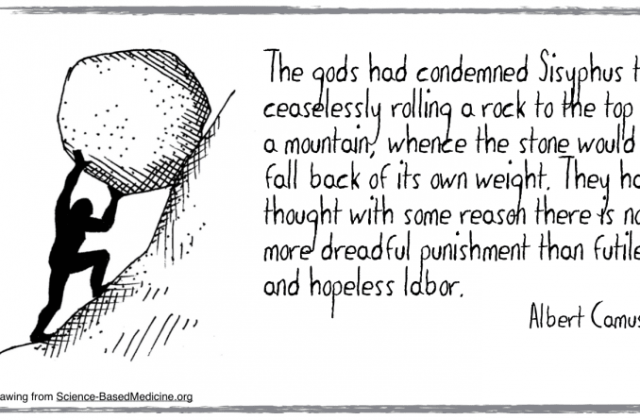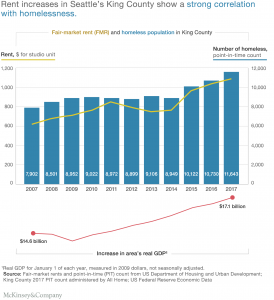Fire, Ready, Aim: The City Already Owns Land to Build Over 2000 Units
I think most people at the City, Crosscut, and the Seattle Times have their e-mail set up so that anything from my address goes directly into the trash. But still, I have to try. This goes back several years to when we were fighting against linkage taxes. I didn’t do this work but I don’t want to get anyone in trouble. The Council isn’t thinking clearly; they are going to pass something that will create more trouble than it solves. But if they all go forward wit this plan, why not just build their housing on land they already own? I don’t know what constitutes a good idea anymore. Maybe this one is stupid too.
Greetings Mayor Durkan and Councilmembers,
The proposed Employees Hours Tax is harmful to our economy because it will discourage job creation and growth. Also, the tax will generate very little benefit for the many people in need, and that small benefit won’t be felt until years from now since building units takes lots more time and money than you’ve accounted for in your estimates.
Notwithstanding these facts, if you’re going to do this, please build housing on City owned land. We’ve already looked at this and you could build the entire inventory you’ve suggested the tax would pay for at the Roosevelt and Beacon Reservoirs:
That’s over 2,000 units, far more than you’ve projected for the tax. And you already own the land!
Please resist the urge to give this money, in whatever amount, to the very inefficient non-profit developers. They would have to find land and they’d have find leverage that currently doesn’t exist. The Seattle Housing Authority in partnership with the City and private developers could turn these City assets into many units of housing much faster and more affordably.
The tax makes no sense, especially in light of that fact that you all have swallowed the McKinsey report whole. Units are expensive and take a long time to build.
If you’re going to do that, give yourself a head start and build on the land you already own.
Roger–
Seattle Sisyphus: Reflections on Where We Are Today
A very smart and trusted colleague and I were sitting in the Neighbor Lady a few weeks ago. He said, “I think you and I, for the foreseeable future, are doomed to keep rolling a rock up a hill just to have it come rolling back down.” His reference to Sisyphus hit home, since from my introduction in 6th grade to the Greek myth of the man punished by forever rolling a rock up a hill but never to get it over has been etched in my mind. Really? Nobody in this town will ever use a calculator? Nobody in Seattle has the sense to stop and look at their attempt at compassion and the policies they are pushing for and see the two things as inconsistent? After the passage of the tax on jobs last week, it might be true.
Later this morning the City Council is going to pass a tax on every hour worked by employees in companies that have net revenues of $20 million per year, about 3 percent of the businesses operating in Seattle. The tax will generate, by City estimates, about $75 million per year, taxing each hour worked by employees at 26 cents an hour, hence the name, The Employee Hours Tax (EHT). Setting aside for a moment what might happen — loss of existing jobs and fewer new jobs created — think of the message such a tax sends: jobs are a bad thing that have a negative impact on our community and must be slowed and offset with a fee.
Taxes should do three things: collect money for public benefits, redistribute money in the economy, and encourage or discourage behavior. When we tax something whether we mean to or not, we send a signal into the economy that using that thing should be limited or avoided. Gas taxes and taxes on cigarettes are just such taxes. The higher tax should translate into fewer gallons of a scarce resource used and in the case of cigarettes fewer deadly things consumed. Meanwhile, the money generated from these kinds of taxes gets used for the other two purposes, paying for things the market isn’t producing like parks or road repair or cheap or free health care.
If, on the other hand, we want the economy to produce more of something to increase its use, then we’d tax it less, not at all or actually have a negative tax, a subsidy for its production and use. To me, this seems like basis stuff.
But here in Seattle, taxes are about punishment.
When your theory of taxation is that it should be used to exact a penalty on a bad actor or someone or something that has done damage to other people or institutions, then there is less concern about the signal it sends. In fact, in the case of the tax on jobs, there is outright denial that it will actually hurt while at the same time saying that it should hurt. The best example of this is the talking out of both sides of the mouth by tax advocates.
One side of Seattle’s mouth says that Amazon has killed off local businesses, wrecked havoc on the local economy by creating lots of high paying jobs. Those high paying jobs in turn create “skyrocketing rents” and economic growth which correlates to homelessness. That’s right, noted consulting firm McKinsey and Company produced a blog post about a study (nobody seems to have the actual study) that concluded that jobs were part of booming cities unintended consequences. The post commits perhaps one of the greatest fouls in argumentation and debate, confusing correlation with causation.
You see, as the economy grows, and rents go up so do the number of homeless people. More prosperity means that there will be more homeless people. That’s how it works. Therefore we need $400 million a year to build housing units for the homeless. Again, that huge figure apparently tracks to construction of units. How many years we have to pay the $400 million is unclear. Councilmember Lorena Gonzalez, after reading the figure reported by Crosscut and the Seattle Times cited the figure as proof, conclusive proof, that we…..wait for it….need to raise $75 million with the jobs tax.
Again, the sophistry used by Gonzalez is childlike but brilliant: You see, McKinsey and the Seattle Chamber of Commerce (who inexplicably paid for the study) say we need $400 million; we’re just asking for $75 million after all. I say childlike because it is the kind of argument a kid in trouble makes to a parent once caught stealing cookies. “I could have taken the whole jar, but I just took one for me and one for my friend.” That shows both restraint and altruism, right?
Meanwhile, David Rolf the relentless campaigner posted on Facebook this meme:
So while McKinsey says that the problem with housing and homelessness is caused by “swelling ranks of high-income digital workers,” the unions are saying that the workers are being exploited and are poor. Hmmm.
The argument for the tax becomes all about how huge the problem is, in fact, Congresswoman Pramila Jayapal says it is “a humanitarian crisis” which calls up images of war, famine, and natural disaster. Wow. A humanitarian crisis that could be solved according to the geniuses at McKinsey with $400 million a year. The need cited by the City is not just homeless which they say stands at 8,500 people but 29,000 cost burdened households earning 30 percent or less of Area Median Income (AMI).
All we’re asking for is $75 million for 356 units a year for a total of 1,780 units five years from now. Surely Jeff Bezos could afford that; he makes more than that in about 7 hours and most of his employees are on food stamps. But they’re also high paid tech workers “propelling” the crisis. Big businesses can afford this tax and they should pay it since, after all, they caused the problem in the first place. This amount we’re asking hurts those businesses just enough that they won’t change their practices. They can afford it.
So there you have it, a tax that is aimed at punishing a company that is damaging the local way of life and creating suffering but that will produce very little, if anything, that will actually ameliorate that suffering. The champions of the tax revel in wringing out Amazon, making them pay, because of the huge problem the company has created; yet, those advocates also say it won’t hurt a bit. And what do we get for all this: less than 5 percent of the units needed, five years from now, for the supposedly 37,850 suffering today.
Something interesting to note about Sisyphus is the question of why he was punished. From the Ancient History Encyclopedia.
He gained infamy for his trickery and wicked intelligence, but his greatest feat was to cheat death and Hades himself, not once but twice, thus living up to Homer’s description of him as “the most cunning of men” (Iliad, 6:153). In the first episode the king, after dying and descending into Hades, audaciously managed to capture Thanatos, the personification of Death, and chain him up so that no humans died thereafter. Only the intervention of Ares resolved the crisis, and Death was freed to pursue his natural work.
Perhaps Sisyphus is far too lofty a metaphor for me and my calculator.
Crosscut and Seattle Times Hand Big Win to Job Tax Advocates
The horse, as they say, is out of the barn. So are the pigs, and the chickens, and all the communists pushing for a tax on jobs in Seattle. The Seattle Times and Crosscut have posted stories about a very poorly argued post about a study by McKinsey Company about the City needing $400 million a year to solve homelessness. It is a study on confusing correlation with causation. This is a mortal sin for anyone who writes anything and cares about making good arguments. For McKinsey it is truly an intellectual embarrassment; blaring out the “findings” in a headline is too, and it is compounding the problem and confusion. Jobs don’t cause homelessness, bad housing policy does. This is my email to the writers and the Times and Crosscut.
Hi David and Vianna,
The guys at McKinsey are smart.
They know the math.
All I did was study philosophy and religion. And you know what, I moved to American religion from Buddhism as a speciality in graduate school. You know why? Hindi and Sanskrit were going to be too hard.
The only “math” I took after high school was something called Logic and Language. I barely got out of there with a C. It hurt my head.
But even I know the difference between correlation and causation. The article you reference in your article is an embarrassment for the authors and by extension your work.
Their graph uses the word “correlation” when it looks at the rise in rents and homelessness, then in this paragraph jumps over another canyon of logic:
In King County, homelessness has risen in line with the fair-market rent (FMR), which has in turn increased in line with the county’s strong economic growth, propelled by the swelling ranks of high-income digital workers. On a single winter night in 2017, volunteers counted 11,643 homeless people, an annual average rise of 9.2 percent since 2014. Over the same period, the FMR has risen an average of 12.3 percent a year.
I love the “winter night” reference for added drama.
Homelessness has increased, they say, because of strong economic growth, which has created high paying jobs. Therefore all that suffering is because of “swelling ranks of high-income digital workers.”
Where is the causation here? How many “high paying jobs?” How many homeless people are homeless because of increases in “fair market rent,” a very specific definition used by HUD?
Then there is a non-sequtor: we need $400 million per year. It just isn’t clear what such a huge amount of money would get us. Is it even possible to build 7,800 units of subsidized housing in our City over 5 years? I’ve looked at annual production numbers of subsidized housing and that number in its peak year was only about 450 units of housing (see attached based on OFM data and numbers from the City).
Never in the last decade have non-profits produced that thousands of units of housing and it wasn’t for lack of funds as much as it is that it takes a long time to acquire land, complete financing, permitting, and construction. But costs are also rising. The average cost for non-profit subsidized housing rose more than 40 percent from about $224,000 per unit to about $324,000 between 2008 and 2016. Those costs are even higher today and rising.
As I have pointed out again and again and again (see one example below) all the money in the world will not overcome the scarcity of land and labor and the rising costs of capital construction. And the number of 244,000 “affordable homes” by 2040 is bizarre. There are, if my memory serves me, about 14,000 subsidized units in the city; that means producing over 10,000 a year over that time period. The entire housing market produced just 39,000 units since 2010 (again OFM data) about 5,500 units per year.
If we were simply to buy down all the cost burden in the city it would only be around $100 million by my rough estimates. Why are we building a few hundred units for lots of money that will be available years from now if people are living here now but a few hundred dollars short on rent?
We’re literally hours away from a Council vote on a disastrous measure being enacted; and it is a disaster not even just because of the loss of jobs it will create, but because it will deliver so little benefit.
We need our journalists to dig deeper into these numbers.
Your stories have handed a very big win to the pro side of this argument without looking more closely at these numbers and asking harder questions about whether or not Mckinsey can prove that jobs are the cause of homelessness.
Of course they aren’t. The cause of housing issues is lack of supply in the face of rising demand created by more jobs. When people who are coming here to work can’t find a place to live, that creates scarcity and higher prices which hits poor people the hardest. Why is this happening? Because the City Council has made it increasingly difficult and expensive to meet rising demand for housing; if there is a crisis it is self made.
Now, those pushing for something that will damage our economy and will bandy about your headlines about this very poorly written article about a report which I haven’t been able to find. We need $400 million per year!
Please, go back and ask these questions. We’re hours away from disaster.
Thank you for listening.
Roger–
Please check out the numbers here: Seattle’s Tax on Jobs Does Next to Nothing for Housing
Seattle City Council: Unhelpful Screening Ban Gets a Court Challenge
The Seattle City Council has demonstrated before it isn’t all that concerned about math, supporting a tax on jobs that is threatening new jobs in the city while producing a tiny number of units, 1,780, five years from now, maybe, at a cost of $285,000,000. Councilmember Lorena Gonzalez claims this small number will somehow address a stated problem of 29,000 cost burdened households and 8,500 homeless. It doesn’t add up. And the Council isn’t worried about violating the law and the Constitution; a recent court decision found that the City’s First In Time (FIT) rule that turned the first person to show up for a rental unit into a part of a protected class violates free speech protections of the First Amendment. Now the Rental Housing Association (RHA) and the Pacific Legal Fund (PLF) are taking on the City’s fancifully named Fair Chance Housing Ordinance that prevents screening of tenants for criminal activity.
You can read the full legal filing here.
The stated intent of the ordinance, giving people coming out of the prison system a chance at housing, simply won’t be achieved by “banning the box.” Landlords will still be screening for credit score, previous rental history, and of course employment and income, all things that are huge challenges for people exiting the system. The problem is not just having a record and being rejected, it’s all those other challenges like trying to find a job and having lousy credit. Also, it’s very easy to get sent back to prison; probation violations can be as small as missing a scheduled meeting with a probation officer or being in the company of someone else in possession of a weapon or drugs.
If banning the box or eliminating screening at application would magically make all these other issues moot, I’d be the first to support the ban. But it doesn’t. It simply creates one more potential violation for landlords screening tenants and when it fails to produce any results, the Council is likely to overreach and band credit and income checks too — just another step in the march to rent control. Renting private property is risky, and the purpose of screening is to limit that risk. What local and state governments could do is provide support to people leaving the system before they even leave with credit clean up, preparing rental histories, and connecting with other helpful services outside to get a job and other support systems. Finally, backing up regular deposits with a risk pool funded by landlords and by government could help offset the risk and make it easier to rent.
All of these things require actual work and coordination, something the City Council doesn’t know how to do. It’s far easier to pass legislation that feels good and adds complexity without any benefit. The problem with the legislation isn’t just that it’s mostly worthless grandstanding it’s also likely also unconstitutional. One obvious argument is that the law prevents private property owners from deciding how they want to rent out their own property. One of the plaintiffs in the case is a family who rents out a nearby property.
The Yims value their right to select their tenants. The Yim family cannot afford to absorb losses because of a tenancy gone bad. And for a family with three children, selecting a tenant who will also be their close neighbor requires careful discretion. The Yims share a yard with their renters, and the Yim children are occasionally at home alone when their renters are home. The Yims treasure their right to ensure compatibility and safety for themselves and their tenants.
To offset risks they likely will have to raise deposits and rents if something goes wrong. It isn’t a question of not liking people with a record, but using available resources to know more about tenants. And while it is true that people or color are more likely to be swept up into the criminal justice system, they are already a protected class. Seattle’s legislation make anyone with a record protected which begs the question, why have criminal records at all. The answer is obvious: people want to know whether a person has committed a crime before entrusting them with money, property, or supervision of children. Being able to use information to screen use by someone else of private property is essential to it being private.
Secondly, the law infringes on free speech.
The Fair Chance Housing Ordinance violates speech rights on its face and as applied by prohibiting individuals and organizations from accessing and sharing truthful information about housing applicants. This prohibition targets speech based on content, speaker identity, and purpose. The Ordinance forbids anyone from inquiring after criminal background for the purpose of vetting housing applicants, but it does not forbid such inquiries for other purposes. This burden on RHA’s and landlords’ speech rights must satisfy heightened judicial scrutiny.
Again, I don’t support anyone denying a person a lease only because they have a record. I doubt any good landlord would. They might ask for a cosigner or an extra deposit, but if every other variable for screening was solid, there’s a much better chance a landlord would give the person that chance. But that’s the point, there’s lots of ways to screen and most people leaving the system or with a record are going to have other disqualifying data. So limiting use of criminal records accomplishes nothing but preventing access and sharing of public information.
If the City truly wanted to make life easier for people getting back on their feet after being in jail, they would develop a collaborative program working with the Department of Corrections, case managers, probation officers, and it would have allocated the resources to help offset risk and even help with the rent by expanding the Earned Release Vouchers that are currently only for three months. Hopefully when this ordinance is struck down, the City and State will come back with something that actually helps rather than just making Councilmembers feel batter about themselves.
I Told You So: Ballard Mob Action is the Product of Years of Pandering by the Council
“Remember that, in the past, those who foolishly sought power by riding the back of the tiger ended up inside . . . we pledge our best efforts to help them help themselves, for whatever period is required–not because the communists may be doing it, not because we seek their votes, but because it is right. If a free society cannot help the many who are poor, it cannot save the few who are rich.”
John F. Kennedy
Inaugural Address
January 20, 1961
If you missed it, last Wednesday, in Ballard, a mob of angry neighbors assembled in a church to express their vitriol at the City Council’s proposed jobs tax – or did they. I was there, and anger was more inchoate. The neighbors were angry at what they see as Councilmember Mike O’Brien’s intransigence on getting rid of homeless people (or criminals as they might call them) from Ballard. Their opposition to the tax was more about opposing wasting more money and time on solutions to camps in Ballard that don’t include some kind of enforcement. Some were breathless about the meeting, suggesting the death of Seattle Nice and marking it as when Seattle Process “went off the rails.” But Wednesday night is simply the fruition of something I’ve seen coming for a long time.
I have finally become inured to my role as Cassandra or Laocoon, the voice in town that warns about upcoming disaster if leaders in the city don’t change their ways. The central part of that narrative is the harbinger ignored. That’s frustrating, but then there’s the part where I get to say, “I told you so.” So, Seattle and Mike O’Brien, I told you so
Back in 2011 I was part of something called the Regulatory Reform Task Force. This was well before the economic recovery we’re in now took hold and took off. Back then the city was in dire need of jobs and investment. Then Mayor McGinn had advertised himself as a reformer and supporter of dense, walkable development. The Task Force assembled with the awareness that we could create both more jobs and economic activity and create sustainable and efficient growth if we pared back costly requirements created by permit review and for parking in dense neighborhoods.
One element of this reform was to allow the possibility of retail in low-rise zones. After changes the year before, in 2010, he low-rise zones or LR zones were ripe for more apartments and live work spaces, so the thought was allow retail in some of those zones as well. The idea was to make higher density LR zones a little bit more like mixed use commercial zones. The change would allow an entrepreneur to live, work, and possibly operate a storefront in the same space; efficient, affordable, and sustainable, right?
Angry neighbors across the city didn’t think so. Stoked by two senior City staff, neighbors across the city, especially on Capitol Hill and Ballard, areas rich with LR zoning threw a fit. This would be the end of the world, as we know it. Forget about the work and effort from a range of stakeholders and the consideration given the idea, the neighbors who lived down the road from LR zones couldn’t stand the idea of even the hint of encroachment on their single-family paradise.
Enter Councilmember Mike O’Brien. The Council was split evenly with four in support of the idea and four against. No problem, right? O’Brien is a champion of sustainability, a bike rider, and fan of density and efficiency through and through, right.
People who live in vibrant, walkable urban centers like Capitol Hill are the people we need on board to guide the future development of the city. We clearly don’t have them on board today.
So a few angry neighbors – led by insiders at City Hall – were enough to kill a rather modest proposal. That neighborhood, was already walkable enough, thank you.
At the time (and I have been culling through years of posts and emails on the topic) I warned that this was the beginning of a broader movement. Usually neighbors in one neighborhood would band together to kill one project. What was different about the killing of the low-rise proposal was it glued together grievances from all across the city. And low-rise changes were just emblematic of change, and opposing them and stopping that change was a way of saying “No!” to changing the “character” of neighborhoods.
The hazard of caving here was, I knew then, that they’d come back for more. And they did. The neighbors demanded and got from O’Brien,
- Killing small-lot single-family development
- Killing microhousing
- Screwing up low-rise zones with what was, in effect, a downzone
- Proposing linkage taxes citywide to slow and stifle growth
- Pushing for the Grand Bargain that became the MHA shake down
- Proposing a plainly illegal requirement for design review for abutting lots (overturned in court)
- Pushing for first in time (overturned in court) and deposit requirements for rentals
When O’Brien pushed for what he knew was a plainly illegal change to design review requirements that would force full design review on projects as small as four or five units he said he was doing it for the neighbors.
O’Brien, who is trying to win favor among a northwest Seattle electorate made up largely of single-family homeowners unhappy with the changes that have come to their neighborhoods, has taken votes to restrict density near single-family zones before. In 2014, O’Brien defended legislation restricting single-family development on small historic lots on the grounds of “protecting neighborhood character,” telling me, “The most egregious examples of what’s being built—I wouldn’t want those in my neighborhood.”
So why would there be any surprise that after capitulating again, and again, and again on a wide range of housing options, killing and slowing them on behalf of the angry mob that they would turn on him for supporting cars and tents as a housing solution. Oddly, I mostly agree with O’Brien on cars and tents and for much of the same reason that we battled for all those other types of housing: they are offering solutions for real people who need shelter and housing.
O’Brien may not be able to see how his statement about, “I wouldn’t want those in my neighborhood” can apply to townhouses and to tents. In fact, it wouldn’t take a big leap in simple logic to see that if you gave the neighbors what they wanted and stopped construction of a townhouse because it was “ugly” that they’d be pissed off, livid, maybe even enraged when you refused to sweep away tents and RVs parked down the street.
I warned about this. I was ignored. Now O’Brien’s career is in jeopardy and the city is seeing what I’ve been seeing for years: an angry, embittered, and hostile mob of single-family homeowners who expect the Council to do exactly what they want. Doesn’t anyone remember Roosevelt where people were shouted down? This has been going on for years. It should be no surprise that a City and a Council that deliberately and stubbornly ignore basic economics, math, and basic principles of good government should find themselves now being yelled at by angry socialists on the left and angry neighbors on the right.
Leadership often means saying, “No.” The Council is now on the verge of imposing a tax that will harm jobs and prosperity in the city for a few hundred units of housing years from now. They’ve fed, pandered, and humiliated themselves at the feet of these different interests for so long in the name of “equity” and “character” that the mobs have learned mob action pays off. Math and engagement with people who build housing and operate it is ignored. Yelling, shouting, cajoling, and threatening pay off.
For they sow the wind, and they will reap the whirlwind. He has no standing grain. The stalk will yield no head. If it does yield, strangers will swallow it up.
Hosea 8 :7









